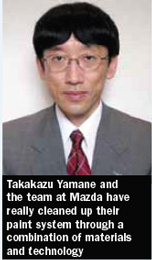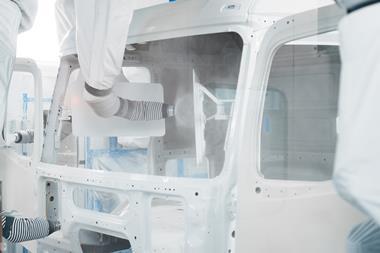
Reducing VOCs and CO2 emissions have been contradictory aims in paintshop for many years, but Mazda has come up with a revolutionary solution
Mazda Motor Corporation recently announced the successful launch of the newly developed Aqua-tech Paint System for vehicle body painting at its Ujina Plant No.1, in Japan. This innovative technology achieves the world’s highest standards for limiting the emissions of volatile organic compounds (VOC) contained in the paint as well as for lowering the carbon dioxide (CO2) gas generated from the energy consumed during the vehicle painting process.
The Aqua-tech Paint System maintains the same worldclass low CO2 emissions volume as the Three Layer Wet Paint System — Mazda’s paint system currently installed at all of its production facilities in Japan — and reduces VOC emissions by a further 57 percent. At only 15 grams per square meter of vehicle body surface, the extremely low VOC emissions volume makes Aqua-tech the least polluting water-based paint system in the world. The new system also delivers improved paint quality.
Cleaner plant and brighter finishes
Water-based paints tend to produce far lower VOC emissions than solvent-based paints due to their low VOC content.
However, drying water-based paint consumes much more energy because the water must be evaporated using a forced drying process. The large quantities of carbon dioxide produced during this process have long been an issue.
The Aqua-tech technology includes the introduction of an improved paint shop air conditioning system and a new, highly efficient evaporation system that removes the water contained in the paint. In addition, Mazda has managed to consolidate the coating processes by developing topcoat paints that possess additional properties, properties that are usually provided by the primer paint.
These include brightness, durability and resistance to chipping and light damage. Two new types of topcoat paint were developed for the Aqua-tech Paint System: a water-based colour basecoat and the first urethane clear coat to be fully implemented by any company in Japan.

Heat and humidity – a delicate balancing act
By changing its approach to air-conditioning the paint booth, the team achieved a 34 percent reduction in energy consumption compared to conventional water-based paint booths.
Conventional water-based paint systems use air conditioning to maintain ideal conditions by keeping both the temperature and humidity at a fixed level. However, this consumes a considerable amount of energy, especially in summer and winter, to heat and cool the air inside and maintain humidity at the prescribed level.
After investigating various drying conditions, the team at Mazda found that the evaporation rate could also be controlled by adjusting the humidity level depending on the ambient temperature in the paint booth. This means that it is no longer necessary to maintain a fixed temperature in the booth.
Depending on the temperature of the air, there is a limit to how much water vapour it can absorb. The speed that paint dries depends on the difference between this limit and the amount of water vapour already in the air. This means that, even when the temperature or humidity changes, if this “difference” can be kept constant, it is possible to achieve a constant paint drying speed, and therefore a constant paint drying time.
Based on this theory, Mazda has developed a system that constantly controls the maximum water vapour absorption volume by monitoring the external air conditions and making the smallest necessary adjustments to temperature and humidity inside the paint booth. The system significantly reduces energy consumption.

Energy saving flash off process
With water-based paint systems, a preheating (flash off) drying process is applied between the base and clear topcoats. By evaporating the water contained in the base coat paint before applying the clear coat, the process is designed to improve the finished paint quality.
Usually the process involves raising the temperature to 80ºC until the paint is sufficiently dry. However, before the clear coat can be applied, the temperature must be reduced back down to 40ºC. If the vehicle body is too hot, the clear coat paint will dry before it has time to spread out, and the final finish will be impaired.
Conventional heating systems blow hot air into the paint booth. However, this method heats the steel vehicle body as well as the paint. Cooling the steel afterwards also consumes large amounts of energy.
In order to reduce the large energy demand for heating and cooling, the Aqua-tech paint system flash off process features an infrared heater. This heats only the paint surface, enabling the water solvent to be evaporated without heating the steel body. The heater can also be switched on and off quickly. This means the amount of heating can easily be optimized for each body size and paint colour. The technology means the water can be efficiently removed with the lowest possible electricity consumption.
Mazda’s flash off process also employs hot air as a support system to heat the vehicle body interiors — where it is hard to use the infrared heater — and efficiently ensure an even temperature throughout. This new system also minimizes the amount of energy needed for cooling, and results in a 17-percent reduction in CO2 emissions compared with common flash off processes.
 APS spoke with Takakazu Yamane, Senior Research Engineer at the Technical Research Center, Mazda Motor Corporation in Japan.
APS spoke with Takakazu Yamane, Senior Research Engineer at the Technical Research Center, Mazda Motor Corporation in Japan.
We began by asking Takakazu to outline the paint system and how it will progress:
We have successfully developed the world’s most eco-friendly paint system. We used water-based paints to significantly reduce VOC emissions and cutting-edge technologies to avoid any increase in CO2 emissions, which have long been an issue with water-based paint. I believe that this will become the global standard for future paint systems. Going forward, we are committed to continue developing eco-friendly coating technologies, such as Aqua-tech and the Three Layer Wet Paint System, in order to contribute to the preservation of the environment.
Tell us about the design and construction – did you use an integrator or full-service supplier?
TY: Mazda independently designed and installed the overall system, with support from a number of suppliers, such as paint companies. Several departments within Mazda, including the Technical Research Center, R&D, and Product Engineering, led the project and Manufacturing, all of which worked closely together to develop and install the system.
APS: Which companies supply the paint materials, including primers, topcoats, and lacquers/clear coats?
TY: Mazda jointly developed the paint in cooperation with Nippon Paint Co., Ltd., BASF Coatings Japan, and Kansai Paint Co., Ltd. These paint makers already supply paint to Mazda for series production.
APS: How did they work with Mazda and the paint shop supplier to 'fit' their paint with the system?
TY: By working closely with the paint makers, we developed highly functional topcoat (base coat and clear coat) paints that also exhibit all the properties usually provided by a primer layer. Also, we worked with equipment manufacturers to develop a new air conditioning system and a preheating (flash off) process to evaporate the water contained in the base coat paint.
APS: Is the painting system completely automated - are there any hand/manual paint operations?
TY: Painting operations for the vehicle body exteriors are completely automated. There are some manual operations for vehicle interiors.
APS: Which company supplies the robots?
TY: Yaskawa Electric Corporation. The paint shop robots themselves are fairly common models, used in series production already.
APS: Which company supplies the paint guns/paint bells/ cartridge system?
TY: ABB Ltd. These are fairly standard water-based paint machines/equipment.
APS: And the conveyor system?
TY: We use a fairly common chain-drive conveyor system.





































